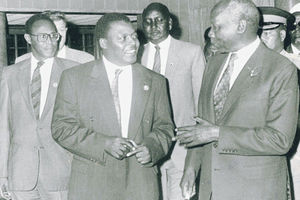
Former Deputy President Rigathi Gachagua remains seated after chaos erupted at a public function in Nyandarua County on December 28, 2024.
Details have emerged on how the police allowed the attack on former Deputy President Rigathi Gachagua, during interdenominational prayers at Shamata Stadium in Nyandarua County, on December 28, 2024.
A chronology of events as they unfolded and investigations by the Independent Police Oversight Authority (Ipoa) paint a picture of a well-planned, choreographed, and executed mission, whose ultimate goal was to allow the commission of crime.
Apart from the police’s attempts to frustrate the prayers from the start, investigations by IPOA also reveal deliberate efforts by Nyandarua police chiefs to defeat justice after the initial plot to stop the gathering failed.
Aberdare sub-County Security Committee approved the interdenominational prayers on Friday evening after days of back-and-forth between the organisers and the security team at sub-county and county levels.
During the incident, a lone attacker, now identified as Police Constable Frederick Gitau, managed to sneak into the public tent with a teargas canister and waited for the church service to end before swiftly moving to disrupt the speeches by politicians who had accompanied the former DP.
Mr Gachagua was about to get invited by Nyandarua Senator John Methu to address the gathering when the officer raced across the podium.
As the diversionary tact by the policeman attracted security attention, a teargas canister was hurled towards Mr Gachagua, dropping about four metres from him and about two metres from Mr Methu who was with the mic.
The canister slowly exploded, emitting its toxic gas, blanketing Mr Gachagua and other VIPs, as the function erupted into confusion with residents giving chase to a suspect and arrested him.
The officer, attached to Muungano Police Station in Athi River sub-County, was handcuffed after live bullets were fired by the security contingent around to save him from mob lynching.
An investigation by Ipoa shows internal conflicts between senior police officers and their juniors might also have contributed to the aborted mission, with unhappy junior officers leaking critical information to the public.
For example, the identity of the errant police officer was revealed within minutes, as a video clip taken in a police vehicle showing him narrating how he was spotted and identified by a former DP blogger, also circulated on social media.
In its findings, Ipoa accused the police of failure to document the events prior to and after the attack, in what the oversight authority describes as laxity, complicity, and professional conduct, and goes ahead to recommend disciplinary action against county security chiefs.
Ipoa confirmed that the suspect, who lobbed the tear gas is a police officer from Athi River Police Station, and raised questions as to why he was never booked at Ndaragwa Police Station, about 30 kilometeres from the scene.
The suspect was escorted to Ndaragwa Police Station in two police vehicles after he was rescued from a mob baying for his blood, and Ipoa read mischief in how the entire scenario was handled by the police.
“The suspect, reportedly a police officer, was subjected to mob justice by the public, before being rescued by the police,” says Ipoa in a report released on January 2, about five days after the incident.
The authority also questioned why at least 60 police officers were deployed at Shamata Stadium without an official operation order.
The officers also had prior intelligence of likely chaos during the event. Still, they failed to act to avert the security breach that disrupted a fundraiser in aid of the churches that had organised the prayers.
Still, according to Ipoa, five suspects intending to disrupt the event were arrested by the police before the event started, but were released under the command of the county police commander.
The suspect's details were also not properly recorded in the Occurrence Book, according to IPOA.
“The county police commander led the operation but did not log her presence in the station’s Occurrence Book,” says IPOA.
“Five suspects were arrested in the morning for planning to disrupt the event but were later released on instructions from the county police commander. The released suspects’ details were not fully recorded in the Occurrence Book, raising accountability concerns.”
The authority also revealed that the suspected police officer was transferred to Ndaragwa Police Station and later released from police custody, but he was not entered into the OB.
Though he had suffered serious injuries from the mob attack, there is no evidence that he was treated at any health facility within.
“The Internal Affairs Unit (IAU) and Independent Police Oversight Authority (IPOA) investigated the suspect’s mysterious release and police handling of the case and concluded the following: That the police failed to handle the arrest and processing of the suspect professionally,” says Ipoa.
“Despite intelligence on potential disruption, no operation order was prepared for public order management of the event. The suspect police officer’s release without formal booking or investigations highlights negligence and possible abuse of authority by the police.”
IPOA adds that after the investigations into police inaction, negligence, and misconduct, it recommends that accountability measures be enforced for officers involved in the inappropriate handling of the incident.
But Mr Methu, an ally of the former DP, says internal disciplinary action is not enough since the incident was planned to cause chaos and harm people.
“Internal disciplinary action is recommended for him as an officer. It doesn’t shield him from taking responsibility as a criminal who threatened lives at a public function, so he must be arraigned in court,” said Senator Methu.









